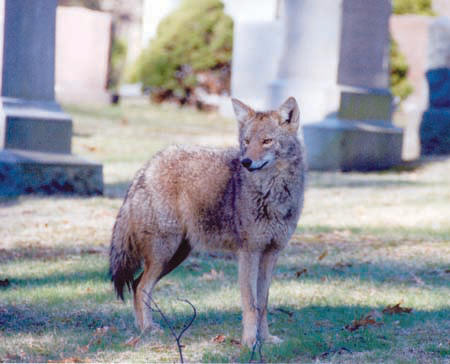June 18, 2009
 Coyote: A coyote takes in the scene at Cedar Grove CemeteryIn the early evening of Fri., May 19, Barbara Kelley looked into her Clancy Road yard across from Walsh Park and saw something move that she thought was a bird. Hardly. She was looking at "a big, beautiful silver-gray coyote" with light-gray eyes and about the size of a German Shepherd, weighing, she guessed, about 65 pounds.
Coyote: A coyote takes in the scene at Cedar Grove CemeteryIn the early evening of Fri., May 19, Barbara Kelley looked into her Clancy Road yard across from Walsh Park and saw something move that she thought was a bird. Hardly. She was looking at "a big, beautiful silver-gray coyote" with light-gray eyes and about the size of a German Shepherd, weighing, she guessed, about 65 pounds.
"He just looked at me and moseyed off," Kelley said. "He just ambled off down the street." Later, a neighbor's gardener found an animal den near the yard.
Kelley called City Hall's 4500 number hotline and was told that her report would be given to the proper authorities, who were gone for the day.
At a neighborhood Crime Watch meeting the following week, Kelley mentioned the incident to Officer Patrice Bennett, the Area B-3 community police officer, who looked into the matter and provided Kelley with information on what to do if you suddenly find yourself confronting uninvited coyote guests.
"The best thing you can do is make a lot of noise," said Massachusetts Division of Fisheries and Wildlife furbearer biologist Laura Hajduk, one of the state's top authorities on coyotes. Naturally afraid of humans, the animals will usually retreat from threatening movements and sounds it is not familiar with. Banging pots and pans, blowing air horns, and old fashioned yelling are all effective methods of temporarily removing a bothersome coyote from your premises, said Hajduk.
The highly adaptable predators find any food source attractive, she said, whether it's a bird feeder, fruiting tree, open compost pile, or garbage barrel. Coyotes will also come to reside in cemeteries, parks, and other areas where small mammals mean quick meals. They maintain home range territories of roughly six square miles per family unit — usually one adult pair, some subordinate adults, and a litter of pups.
The state Environmental Police are the only law enforcement agents authorized to physically deal with coyotes in Massachusetts, according to Kate Ploud, a spokesperson for the Massachusetts Executive Office of Energy and Environmental Affairs. Calls to local police and animal control agencies will be routed to the Environmental Police, she said. The agency, under the jurisdiction of the EOEEA, has 90 officers statewide and ten based in Boston. They can be reached directly at 1-800-632-8075.
Coyotes may seem like a new addition to the Dorchester ecosphere, but they have been living in all parts of eastern Massachusetts since the 1950s. As the animals adapt and grow more familiar with humans with each passing generation, Hajduk said, they make themselves known in more and more urban environments.
"We have coyotes basically in every town in Massachusetts except Martha's Vineyard and Nantucket," Hajduk said. The best line of defense for residents, she said, is to discourage coyotes from coming into your yard by making it as undesirable, and free of food, as possible.
"It takes just one feeding," for coyotes to associate people with food, she added.
"The best approach is proactive," agrees Jennifer Wooliscrosft, from the Animal Rescue League of Boston, who also recommends that information regarding coyotes and other urban wildlife be provided to pet owners and other residents.
While there have been only three total recorded cases of coyotes attacking humans in Massachusetts (two of the animals were rabid), it is unclear how many unprotected pets have fallen victim.
And Barbara Kelley now wonders if coyotes may have been the culprits in the disappearance of her young cat about a year ago. "One day it went out and never came back," she said.
Topics:



